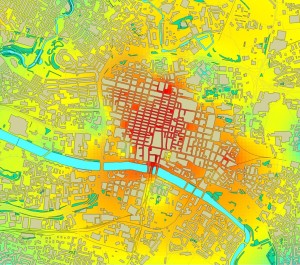‘Little improvement’ in Scottish air quality in 2014
Levels of NO2 and PM10 increase slightly at several monitoring sites in Scotland, but draft low emission strategy promised this month
Air pollution worsened in several places in Scotland last year, according to campaign group Friends of the Earth (FoE), which is calling for support for low emission zones and more emphasis on walking and cycling.
Data compiled by FoE Scotland from the Scottish Government’s monitoring network shows that 13 monitoring sites in Scotland breached the annual average limit for nitrogen dioxide of 40ugm3 in 2014, while 19 sites breached the 18ugm3 annual limit for PM10.

Heat map of Glasgow in 2014 showing highers levels of pollution in red areas (image: Friends of the Earth Scotland)
And, the data shows that levels of nitrogen dioxide increased slightly at four sites — two of which are in the Scottish capital of Edinburgh — compared to the previous year. Levels of particulate matter PM10 also rose slightly at five sites.
The Scottish Government said it was working to further improve air quality and also highlighted its intention to issue a draft Low Emissions Strategy for consultation later this month.
However, FoE Scotland said the figures “persistently broke Scottish and European air quality standards” last year, which confirmed that air pollution remains a “public health crisis in Scotland”.
Emilia Hanna, air pollution campaigner for Friends of the Earth Scotland, said that while the data showed “little sign of improvement”, if the Scottish Government got it right, the Low Emissions Strategy would save “thousands of lives” each year
She said: “To have any chance of success this strategy must provide money for cash-strapped councils to pay for desperately-needed measures on air pollution. It is very worrying that the Draft Budget shows no increase in funds for action on air pollution and suggests the Scottish Government plans on spending 200 times as much money next year on building new roads as on tackling deadly air pollution.”
Results
The data, based on a combination of roadside and kerbside monitoring stations, was compiled from information included on the Scottish Government’s air quality monitoring website and on “further discussions with consultants at Ricardo-AEA”, according to FoE.
The latest data covers the period from January 1 2014 until December 31 2014.
According to FoE data, the monitoring sites in Scotland where nitrogen dioxide levels appear to be worsening are: Edinburgh’s St John’s Road (increase of 3 microgrammes per cubic metre), Edinburgh’s Queensferry Road (increase of 1), Dundee’s Whitehall Street (increase of 2ugm3), Falkirk’s West Bridge Street (increase of 3ugm3), Rutherglen’s Main Street (increase of 4 ugm3).
In addition, the data shows particulate matter has worsened at: Aberdeen’s Wellington Road (increase of 1ugm3), Newton in West Lothian (increase of 3ugm3), Chapelhall’s Main Street (increase of 4ugm3), the A8 in Greenock (increase of 4ugm3), and Whirlies Roundabout in East Kilbride (increase of 4ugm3).
Scottish Government
Government statistics estimate that there are 2,000 premature deaths each year in Scotland caused by air pollution.

Friends of the Earth graph showing NO2 levels at 13 monitoring sites in Scotland in 2014 (click to enlarge)Â
A spokesperson for the Scottish Government said that it was working with Scotland’s 32 local authorities and “continues to make progress in improving air quality”, adding that data shows “significant reductions” in air pollutants since 1990 and “further decreases are predicted in future”.
However, the spokesperson said the Scottish Government recognised that “there is more to be done” to tackle air pollution, which “disproportionately affects the health of the most vulnerable members of society — the very young, the elderly and those with existing cardiovascular and respiratory conditions — and can have a very real impact on quality of life for these individuals”.
The Scottish Government spokesperson also highlighted plans to launch a draft Low Emission Strategy for consultation later this month (see airqualitynews.com story), which will “set out the contribution that reduced air pollution can make to delivering sustainable economic growth and enhancing the quality of life for communities across Scotland, with a focus on progress in Scottish towns and cities over the coming years”.







 Network
Network